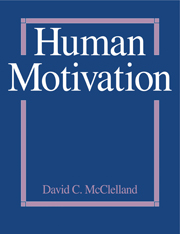Book contents
- Frontmatter
- Preface
- Foreword
- Contents
- Part 1 Background
- Part 2 The Nature of Human Motives
- 4 Emotions as Indicators of Natural Incentives
- 5 Natural Incentives and Their Derivatives
- 6 Measures of Human Motive Dispositions
- Part 3 Important Motive Systems
- Part 4 Contextual Effects on Human Motives
- Bibliography
- Acknowledgments
- Index
5 - Natural Incentives and Their Derivatives
Published online by Cambridge University Press: 05 July 2014
- Frontmatter
- Preface
- Foreword
- Contents
- Part 1 Background
- Part 2 The Nature of Human Motives
- 4 Emotions as Indicators of Natural Incentives
- 5 Natural Incentives and Their Derivatives
- 6 Measures of Human Motive Dispositions
- Part 3 Important Motive Systems
- Part 4 Contextual Effects on Human Motives
- Bibliography
- Acknowledgments
- Index
Summary
• HOW NATURAL INCENTIVES INFLUENCE THE DEVELOPMENT OF THE HUNGER MOTIVE
Much has been learned about the factors that affect eating in animals and humans. The purpose of this chapter is not to review all this knowledge, but to learn from it as much as we can about the way motives develop out of sign Stimuli and the behavior they release, or what we have called natural incentives. The advantage of using hunger as the model for this purpose is that everyone agrees that some of the sign Stimuli involved produce innate affects and that enough research has been done on eating in animals and humans to show how motives might develop out of these innate affects through learning.
To oversimplify somewhat, three types of sign Stimuli influence eating: (1) sign Stimuli arising from nutritional deficiency, particularly low levels of available blood sugar (Mayer, 1955; Mayer & Marshall, 1956), which increase eating; (2) sign Stimuli arising from the palatability or tastiness of food; and (3) sign Stimuli arising from satiety, such as a full stomach or high blood sugar level, which decrease eating. Ordinarily the mechanisms involved operate automatically to make sure the body has enough energy (represented as available blood sugar) to do its work.
- Type
- Chapter
- Information
- Human Motivation , pp. 130 - 171Publisher: Cambridge University PressPrint publication year: 1988



